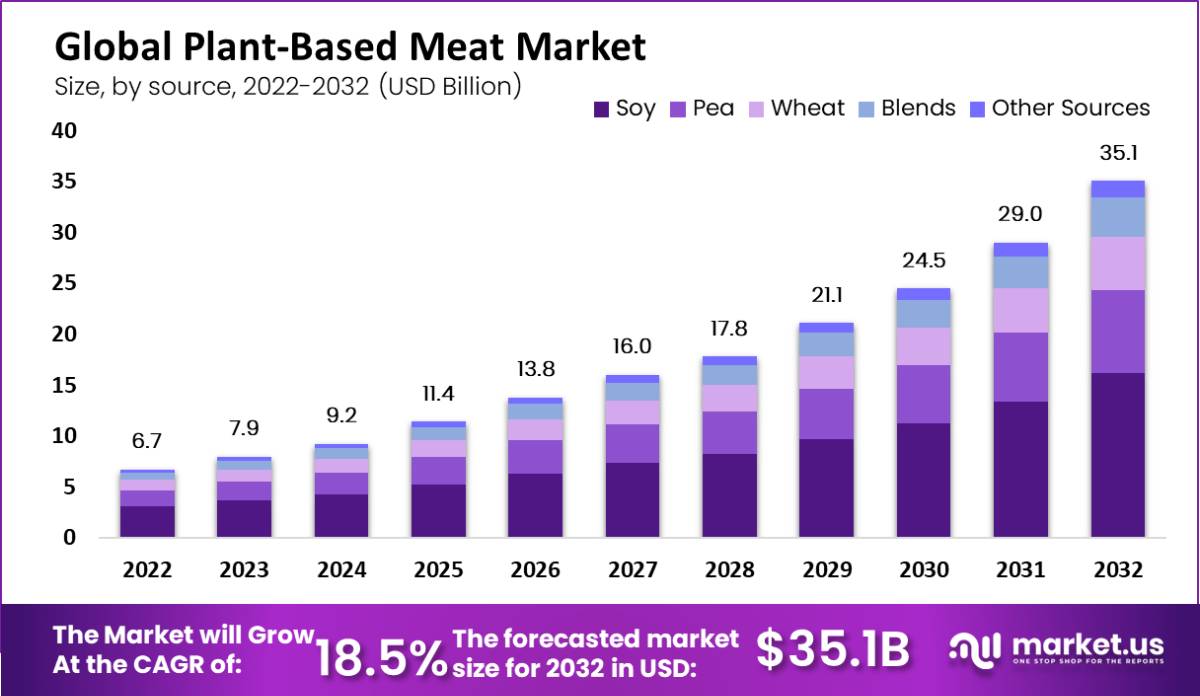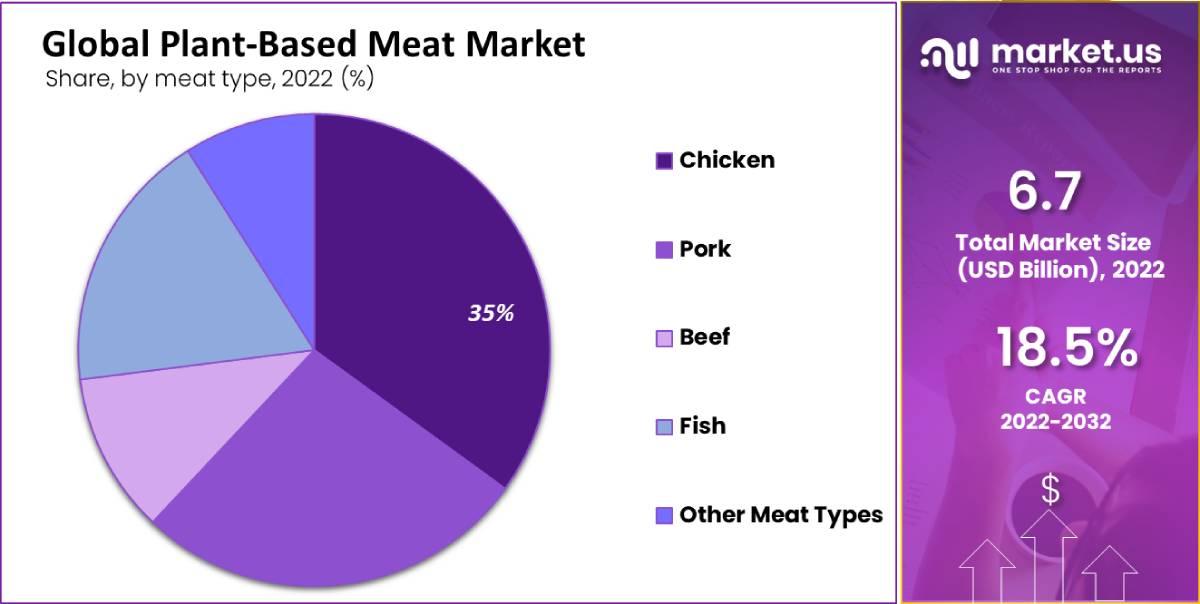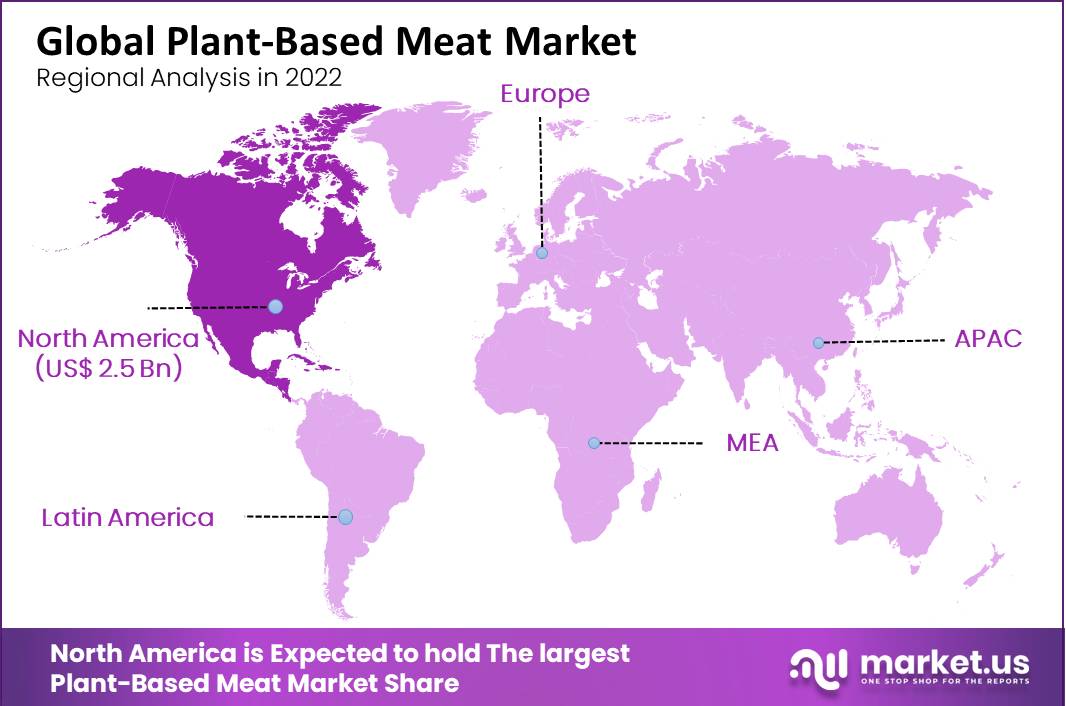New York, Jan. 23, 2024 (GLOBE NEWSWIRE) -- As per the latest analysis by Market.us, the Global Plant-Based Meat Market value is expected to total USD 6.7 billion in 2022. Overall, Plant-Based Meat demand is projected to increase at 18.5% CAGR throughout the forecast period (2024-2033). Accordingly, the total market valuation is set to reach USD 35.1 billion by 2032.
The term "Plant-Based Meat" refers to food products that replicate the taste, texture, and nutritional profile of traditional animal-derived meat but are made entirely from plant-based ingredients. These products are designed to offer a sustainable and cruelty-free alternative to conventional meat products, addressing environmental, ethical, and health concerns associated with traditional meat consumption.
Plant-based meats are typically crafted using various plant protein sources such as soy, peas, wheat, or fungi like mushrooms. These ingredients are processed and combined to mimic the appearance, flavor, and mouthfeel of meat products. Common plant-based meat alternatives include burgers, sausages, nuggets, and ground meat.
The market for plant-based meat has experienced significant growth in response to the increasing demand for sustainable and cruelty-free food options. Factors driving this growth include concerns about environmental sustainability, animal welfare, and the desire for healthier dietary choices. As a result, numerous food companies and startups have entered the plant-based meat market, offering a wide range of innovative and delicious plant-based alternatives to traditional animal-based products.
To Understand Geography Trends, Download Sample Report Here: https://market.us/report/plant-based-meat-market/request-sample/

Market Statistics
- Market Growth: From 2023 to 2032, the global plant-based meat market grew to USD 6.7 billion with a CAGR of 18.5%.
- Primary Sources: Main ingredients in plant-based meats include soy, peas, and mushrooms, catering to health and environmental concerns.
- Source Analysis: In 2022, soy-based meat products dominated the market, contributing to 46% of total revenue.
- Meat Type Analysis: Plant-based chicken emerged as the market leader with a 35% share in 2022, surpassing other meat types.
- Beyond Burgers Product Analysis: Beyond Burgers have 35% less fat than traditional meat and offer lower cholesterol levels.
- Storage Analysis: In 2022, frozen plant-based meats led the storage category, accounting for 55% of the market's revenue.
- End User Analysis: The food industry, especially ready-to-eat meals, is expected to grow rapidly, driven by consumer demand.
- Market Drivers: Growth is propelled by environmental concerns, health awareness, and rising vegetarian and vegan diets.
- Challenges: The sector faces hurdles in comparison to traditional meat, necessitating ongoing R&D to improve and correct misconceptions.
- Regional Dominance: In 2022, North America led the market, holding 38.5% of the revenue, influenced by concerns over unhygienic animal-derived meats.
Find additional highlights on the growth strategies adopted by vendors and their product offerings, Buy Sample Report.
Factors Affecting the Growth of the Plant-Based Meat Market
- Health and Wellness Trends: Increasing awareness of the health benefits associated with plant-based diets.Growing concerns about the environmental and health impacts of consuming red and processed meats.
- Environmental Sustainability: Rising awareness of the environmental impact of conventional meat production, such as deforestation, water usage, and greenhouse gas emissions. Consumer interest in reducing their carbon footprint and choosing more sustainable food options.
- Animal Welfare Concerns: Growing awareness and ethical concerns related to animal welfare in the meat industry. The desire to support cruelty-free and humane alternatives to traditional meat.
- Innovation and Product Development: Ongoing research and development efforts to improve the taste, texture, and nutritional profile of plant-based meat products. Introduction of new and diverse plant-based meat alternatives, including burgers, sausages, chicken substitutes, and more.
- Investments and Partnerships: Increased investments from both traditional food industry players and venture capitalists in plant-based meat companies. Collaborations and partnerships between food companies and plant-based startups to expand product offerings and distribution channels.
- Retail Expansion: Widening availability of plant-based meat products in mainstream supermarkets and grocery stores. Expansion of plant-based meat offerings in fast-food chains and restaurants.
Report Segmentation of Plant-Based Meat Market
Source Analysis
The information provided highlights the dominance of the soy-based meat segment in the global plant-based meat market, accounting for the largest revenue share in 2022 at 46%. This dominance is attributed to the richness of soy in essential amino acids, making it a sought-after source of plant-based meat. The nutritional benefits of soy, including low calories, various vitamins, and minerals, contribute to its popularity, especially for health-conscious consumers. Additionally, soy-based meat is recognized for its positive impact on exercise performance, muscle building, and recovery, further driving its demand.
The analysis also suggests that soy-based meat offers advantages over conventional animal-based meat, such as lower formulation costs and a reduced carbon footprint. This aligns with the broader trend of consumers seeking sustainable and environmentally friendly food choices. The forecast indicates a rapid growth expectation for the pea-based meat segment, driven by its high energy content, protein value, and nutritional benefits compared to traditional animal-based meat products. The qualities of pea-based meat, such as being a good source of folate, iron, and fibers, along with lower saturated fats, position it as an attractive option in the evolving plant-based meat market.
Meat Type Analysis
The plant-based chicken segment takes the lead in the plant-based meat market, commanding the largest market revenue share of 35% in 2022. This dominance can be attributed to the fact that chicken, with its high content of animal fats, proteins, and cholesterol, is a key ingredient in various traditional meat products like patties, cutlets, and nuggets. Plant-based chicken products offer a comparable nutritional profile to traditional chicken, containing the same levels of proteins and other essential nutrients.
This similarity in nutritional value contributes to the growing demand for plant-based chicken as a substitute for conventional animal-based chicken products. The plant-based pork meat segment is anticipated to witness the fastest compound annual growth rate (CAGR), driven by the increasing popularity of pork meat alternatives. Made from pea protein and soy, these products offer high protein and fiber content, zero cholesterol, and lower fat levels compared to traditional pork.

Product Type Analysis
The dominance of the plant-based meat market is evident in the burger patties segment, which commands the largest market revenue share at 30% in 2022. Burger patties are favored for their flavor, texture, and aroma, replicating the characteristics of traditional meat. Typically crafted from ingredients like soy and pea protein, plant-based meat burgers are not only enriched with nutrition but also boast a diverse range of flavors, contributing to their popularity among consumers.
Notable examples include Beyond burgers, which offer a healthier alternative with 35% less fat and lower cholesterol compared to beef burgers. The plant-based sausages segment is poised for rapid growth, driven by companies like Beyond Meat and Lightlife Foods Inc. introducing appealing alternatives to traditional sausages, anticipating increased demand in the forecast period.
Storage Analysis
The dominance of the frozen plant-based meat segment is evident, holding the largest market revenue share at 55% in 2022. This popularity is fueled by the growing demand for innovative vegetarian food products. Frozen plant-based meat products offer a prolonged shelf life, lasting six to eight months without compromising nutritional value, taste, odor, or texture.
This extended shelf life contributes to the increasing demand for frozen plant-based meat in the market. Conversely, the refrigerated plant-based meat segment is expected to experience the fastest compound annual growth rate (CAGR) in the forecast period, driven by rising demand in the food and beverage industries.
End-User Analysis
The dominant segment in the market, with the largest market revenue share at 58% in 2022, is the Hotel, Restaurants, and Café (HoReCa) category. The surge in popularity of vegan and healthy food choices has prompted numerous establishments, including restaurants, hotels, casual dining, and fast-food chains, to offer meat-free options, aligning with consumer preferences.
The growing trend of hosting celebrations and events in restaurants and luxury-class hotels further propels the demand for vegan meat in this segment. Simultaneously, the food industry is expected to experience the fastest compound annual growth rate (CAGR) during the forecast period, driven by the increasing consumer demand for packed ready meals.
For a better understanding, refer to this sample report, which includes corresponding tables and figures@ https://market.us/report/plant-based-meat-market/request-sample/
Key Market Segments
By Source
- Soy
- Pea
- Wheat
- Blends
- Other Sources
By Meat Type
- Chicken
- Pork
- Beef
- Fish
- Other Meat Types
By Product Type
- Burger Patties
- Sausages
- Strips & Nuggets
- Meatballs
- Other Product Types
By Storage
- Refrigerated
- Frozen
- Shelf-Stable
By End-User
- HoReCa
- Food Industry
- Households
Driver: Increasing Consumer Preference for Vegan Diets Driving the Growth of the Market
The growth of the plant-based meat market is primarily driven by the increasing preference for vegan diets among consumers. Changing lifestyles, coupled with a heightened awareness of health and animal welfare, contribute to the rising demand for plant-based meat products. Soy-based meat, known for its high protein content and benefits for athletes, attracts sportspersons towards plant-based alternatives. The market sees further expansion due to the wide variety of flavors and options available.
Additionally, the health benefits associated with plant-based meat, such as fiber-rich compositions aiding digestion and muscle development, contribute to its popularity among health-conscious individuals. The market's growth is also fueled by the demand for refrigerated plant-based meat, perceived as a healthier alternative with low saturated fats, zero cholesterol, and high vitamin and fiber content. Increasing interest in pea proteins for dietary supplements further propels the global plant-based meat market.
Restraining Factors: Negative Health Impacts with High Consumption of Plant-Based Meat Restraining the Market Growth
The growth of the plant-based meat market faces potential constraints due to negative health impacts associated with high consumption. The increasing costs of plant-based meat products and their lack of essential omega-3 fatty acids, proteins, and nutrients compared to animal-based meat could hinder market expansion.
The highly processed nature of plant-based meat products, aimed at enhancing flavor, aroma, and texture, is noted for reducing their overall nutritional value, posing a challenge to market growth. Furthermore, the comparatively high sodium content in most plant-based meat products, around 600 milligrams, raises concerns for negative health consequences, including an increased risk of high blood pressure.
Opportunity: Rising Concerns About Health Concerns of Animals Expected to Create Lucrative Growth Opportunities
The forecast period presents lucrative growth opportunities for the plant-based meat market, driven by rising concerns about the health and welfare of animals. The increasing popularity of plant-based meat products among individuals, coupled with a focus on enhancing nutritional values by food producers, is expected to propel market growth. Governmental efforts to prevent cruelty to animals provide additional opportunities for the vegan meat sector.
The growing consumer preference for plant-based meats, coupled with the rising demand for flexitarian diets, is anticipated to boost market expansion. Furthermore, the increased utilization of plant-based meats in the food industry and the growing trend of physical activities, including gym and sports club participation, contribute to the market's potential for growth, as individuals seek plant-based soy meat for its benefits in fast recovery and muscle development.
Trending Factors: The high Demand for Soy Meat among Health Conscious Individuals is a Current Trend
Global health concerns have led to an uptick in physical activities like Zumba, yoga, and sports, prompting individuals to opt for soy meat as a recovery diet due to its benefits in water absorption and muscle recovery. The rising prevalence of obesity and the increasing focus on fat loss are driving people towards vegan plant-based meat alternatives.
To cater to diverse consumer preferences, food producers are introducing a variety of flavors in vegan meats to attract more customers. Notably, several key players in the market are adopting strategic approaches such as mergers, joint ventures, and acquisitions to gain a competitive advantage.
Buy Now this Premium Report to Grow your Business: https://market.us/purchase-report/?report_id=102022
Competitive Landscape
The competitive landscape of the market has also been examined in this report. Some of the major players include:
- Beyond Meat Inc.
- Impossible Foods Inc.
- Maple Leaf Foods Inc.
- Vegetarian Butcher
- Conagra Inc.
- Kellogg NA Co.
- Marlow Foods Ltd.
- Amy’s Kitchen Inc.
- Tofurky
- Gold&Green Foods Ltd.
- Praeger’s Sensible Foods
- VBites Foods Ltd.
- LikeMeat GmbH
- Lightlife Foods Inc.
- Trader Joe’s
- The Hain-Celestial Canada ULC
- Marlow Foods Ltd.
- Ojah B.V.
- Eat Just Inc.
- No Evil Foods
- Other Key Players
Scope of the Report
| Report Attributes | Details |
| Market Value (2023) | US$ 6.7 Billion |
| Forecast Revenue 2033 | US$ 35.1 billion |
| CAGR (2024 to 2033) | 18.5% |
| North America Revenue Share | 38.5% |
| Base Year | 2023 |
| Historic Period | 2018 to 2022 |
| Forecast Year | 2024 to 2033 |
Regional Analysis
In 2022, North America emerged as the dominant region in the global plant-based meat products market, holding the largest revenue share at 38.5%. The market's growth in North America is fueled by heightened consumer awareness of potential contamination in meat products, leading individuals to shift towards daily consumption of plant-based flexitarian diets.
Additionally, the rising trend of veganism in the region is a significant factor contributing to market expansion. Looking ahead, Europe is anticipated to experience the fastest compound annual growth rate (CAGR) during the forecast period, driven by an increasing demand for vegan meat products and stringent government regulations addressing animal cruelty concerns in the region.

By Geography
- North America
- The US
- Canada
- Europe
- Germany
- France
- The UK
- Spain
- Italy
- Russia
- Netherland
- Rest of Europe
- APAC
- China
- Japan
- South Korea
- India
- Australia
- New Zealand
- Singapore
- Thailand
- Vietnam
- Rest of APAC
- Latin America
- Brazil
- Mexico
- Rest of Latin America
- Middle East & Africa
- South Africa
- Saudi Arabia
- UAE
- Rest of MEA
Recent Developments
- In September 2021, Beyond Meat announced it would begin selling its vegan chicken tenders in retail stores, including Walmart.
- In February 2021, Beyond Meat partnered with McDonald’s and Yum Brands. This deal brings choices to the menu, such as the Mcplant Burger and plant-protein-based pizza toppings.
Browse More Related Reports
- 3D printing plastic market was valued at USD 797 million. Between 2023 and 2032, this market is estimated to register the highest CAGR of 24.6%. It is expected to reach USD 6804 million by 2032.
- Permanent Magnets Market was valued at USD 35 Billion. This market is estimated to reach USD 78.9 Billion in 2032 at the highest CAGR of 8.7% between 2023 and 2032.
- Biomethane Market was valued at USD 3.4 Billion and is expected to reach around USD 6.1 Billion by 2032. Between 2023 and 2032, this market is estimated to register the highest CAGR of 6.1%.
- Architectural Coatings market size is expected to be worth around USD 139.8 billion by 2033, from USD 85 billion in 2023, growing at a CAGR of 5.1% during the forecast period from 2023 to 2033.
- Carbon dioxide market size is expected to be worth around USD 18.3 billion by 2033, from USD 10.8 billion in 2023, growing at a CAGR of 5.4% during the forecast period from 2023 to 2033.
- Thermal paper market size is expected to be worth around USD 6.3 billion by 2033, from USD 4.15 billion in 2023, growing at a CAGR of 4.3% during the forecast period from 2023 to 2033.
- Nitrogenous Fertilizer Market size is expected to be worth around USD 111.2 billion by 2033, from USD 63.9 billion in 2023, growing at a CAGR of 5.7% during the forecast period from 2023 to 2033.
- Synthetic Paper market size is expected to be worth around USD 1989 Million by 2033, from USD 1132 Million in 2023, growing at a CAGR of 5.8% during the forecast period from 2023 to 2033.
- Sorbitol market size is expected to be worth around USD 3387.8 Million by 2033, from USD 1771.2 Million in 2023, growing at a CAGR of 6.7% during the forecast period from 2023 to 2033.
- Naphtha market size is expected to be worth around USD 407.8 billion by 2033, from USD 283.6 billion in 2023, growing at a CAGR of 3.7% during the forecast period from 2023 to 2033.
About Us
Market.US (Powered by Prudour Pvt Ltd) specializes in in-depth market research and analysis and has been proving its mettle as a consulting and customized market research company, apart from being a much sought-after syndicated market research report-providing firm. Market.US provides customization to suit any specific or unique requirement and tailor-makes reports as per request. We go beyond boundaries to take analytics, analysis, study, and outlook to newer heights and broader horizons.
Follow Us On LinkedIn Facebook Twitter
Our Blog:
